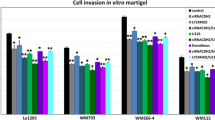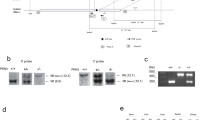Abstract
Metastasis is a sequence of events including proliferation, migration, adhesion, invasion and subsequent metastatic growth of tumour cells in distant organs. We previously showed that highly metastatic variants of murine melanoma cells express higher levels of the basement membrane proteoglycan perlecan than low or non metastatic variants and expression of an antisense perlecan can reduce metastatic potential. In contrast, antisense expression of perlecan in fibrosarcoma cells was reported to enhance tumorigenesis. To better understand the role of perlecan in angiogenesis we have transfected KS-IMM, an immortalized cell line derived from a human Kaposi’s sarcoma, with an antisense perlecan construct and investigated the positive/negative role of perlecan in KS. KS-IMM cells were transfected with either empty vector (neo) or the antisense perlecan construct and clones were isolated. Immunoblot analysis showed a reduction of perlecan levels in two (AP3 and AP4) isolated clones, in Northern blot analysis endogenous perlecan was undetectable in the AP3 and AP4 clones, while it was present in the neo control clones. AP clones had a reduced migration to HGF in Boyden chambers as compared to neo clones. Proliferation in low serum or serumfree conditions was strongly reduced in the AP clones as compared to the neo control cells. The neotransfected cells showed rapid proliferation in low serum supplemented with HGF and VEGF, while antisense transfected clones showed little response. Finally, AP-trasfected KS-IMM cells had significantly reduced migration to VEGF and HGF with respect to controls. In contrast, when the AP transfected cells were injected in nude mice they paradoxically showed enhanced tumor growth as compared to controls. Our preliminary data indicate that perlecan reduction plays a crucial role on Kaposi’s sarcoma cell migration and proliferation in vitro. However, in vivo KS-IMM depleted of perlecan had a growth advantage. A possible hypothesis is that perlecan is necessary for growth of KS-IMM cells in vitro, however its downregulation might promote angiogenesis through increased angiogenic growth factor diffusion, resulting in enhanced tumor growth in vivo.
Similar content being viewed by others
References
Adatia R, Albini A, Giunciuglio D, et al: Suppression of invasive behaviour of melanoma cells by stable expression of antisense perlecan cDNA. Annals Oncology 8:1257–1261, 1997.
Albini A: Tumor and endothelial cell invasion of basement membranes. Pathology Oncology Res. 4:1–12, 1998.
Albini A, Paglieri I, Orengo G, et al: The β-core fragment of human Chorionic Gonadotropin (hCG) inhibits growth of Kaposi’s sarcoma-derived cells and a new immortalized Kaposi’s sarcoma cell line. AIDS 11:713–721, 1997.
Arikawa-Hirasawa E, Watanabe H, Takami H, et al: Perlecan is essential for cartilage and cephalic development. Nat Genet 23:354–358, 1999.
Armes J: A review of Kaposi’s sarcoma. Advan. Cancer Res. 53:73–87, 1989.
Aviezer D, Hecht D, Safran M, et al: Perlecan, basal lamina proteoglycan, promotes basic fibroblast growth factor-receptor binding, mitogenesis, and angiogenesis. Cell 79:1005–1013, 1994.
Aviezer D, Iozzo RV, Noonan DM, et al: Suppression of autocrine and paracrine functions of basic fibroblast growth factor by stable expression of perlecan antisense cDNA. Mol. Cell Biol. 17:1938–1946, 1997.
Aviezer D, Levy E, Safran M, et al: Differential structural requirements of heparin and heparan sulfate proteoglycans that promote binding of basic fibroblast growth factor to its receptor. J Biol Chem 269:114–121, 1994.
Chomczynski P, Sacchi, N: Single-step method of RNA isolation by acid guanidinium thiocyanate-phenol-chloroform extraction. Anal. Biochem. 162:156–159, 1987.
Cornali E, Zietz C, Benelli R, et al: Vascular endothelial growth factor regulates angiogenesis and vascular permeability in Kaposi’s sarcoma. Am J Path 149:1851–1869, 1996.
Costell M, Gustafsson E, Aszodi A, et al: Perlecan maintains the integrity of cartilage and some basement membranes. J Cell Biol 147:1109–1122, 1999.
Ensoli B, Gendelman R, Markham P, et al: Synergy between basic fibroblast growth factor and HIV-1 tat protein in induction of Kaposi’s sarcoma. Nature 371:674–680, 1994.
Ferrara N: Molecular and biological properties of vascular endothelial growth factor. J Mol Med 77:527–543, 1999.
Flore O, Rafii S, Ely S, et al: Transformation of primary human endothelial cells by Kaposi’s sarcomaassociated herpesvirus. Nature 394:588–92, 1998.
Gallo RC: Some aspects of the pathogenesis of HIV-1-associated Kaposi’s sarcoma. J Natl Cancer Inst Monogr 1998:55-57, 1998.
Gunning P, Leavitt J, Muscat G, et al: A human b-actin expression vector system directs high-level accumulation of antisense transcripts. Proc Natl Acad Sci USA 84:4831–4835, 1987.
Inki P, Jalkanen M: The role of syndecan-1 in malignancies. Ann Med 28:63–67, 1996.
Joseph SJ, Ford MD, Barth C, et al: A proteoglycan that activates fibroblast growth factors during early neuronal development is a perlecan variant. Development 122:3443–3452, 1996.
Kjellen L, Lindahl, U: Proteoglycans: structures and interactions. Annu Rev Biochem 60:443–475, 1991.
Maler JAM, Mariotti M, Albini A, et al: Over-expression of Hepatocyte Growth Factor in human Kaposi’s Sarcoma. Int J Cancer 65:168–172, 1996.
Mali M, Elenius K, Miettinen HM, et al: Inhibition of basic fibroblast growth factor-induced growth promotion by overexpression of syndecan-1. J Biol Chem 268:24215–24222, 1993.
Masood R, Cai J, Zheng T, et al: Vascular endothelial growth factor/vascular permeability factor is an autocrine growth factor for AIDS-Kaposi sarcoma. Proc Natl Acad Sci USA 94:979–984, 1997.
Mathiak M, Yenisey C, Grant DS, et al: A role for perlecan in the suppression of growth and invasion in fibrosarcoma cells. Cancer Res 57:2130–2136, 1997.
Naidu YM, Rosen EM, Zitnick R, et al: Role of scatter factor in the pathogenesis of AIDS-related Kaposi Sarcoma. Proc Natl Acad Sci USA 91:5281–5285, 1994.
Noonan D, Albini A, Horigan E, et al: The basement membrane heparan sulfate proteoglycan: structure and expression in melanoma cells. Proceedings of the AACR 31:82, 1990.
Noonan DM, Fulle A, Valente P, et al: The complete sequence of perlecan, a basement membrane heparan sulfate proteoglycan, reveals extensive similarity with laminin A chain, low density lipoprotein-receptor and the neural cell adhesion molecule. J Biol Chem 266:22939–22947, 1991.
Nurcombe V, Ford MD, Wildschut JA, et al: Developmental regulation of neural response to FGF-1 and FGF-2 by heparan sulfate proteoglycan. Science 260:103–106, 1993.
Rapraeger AC, Krufka A, Olwin BB: Requirement of heparan sulfate for bFGF-mediated fibroblast growth and myoblast differentiation. Science 252:1705–1708, 1991.
Sakata H, Stahl SJ, Taylor WG, et al: Heparin binding and oligomerization of hepatocyte growth factor/scatter factor isoforms. Heparan sulfate glycosaminoglycan requirement for Met binding and signaling. J Biol Chem 2729457–9463, 1997.
Schulz TF: Epidemiology of Kaposi’s sarcoma-associated Herpesvirus/human Herpesvirus 8. Adv Cancer Res 76:121–160, 1999.
Sharma B, Handler M, Eichstetter I, et al: Antisense targeting of perlecan blocks tumor growth and angiogenesis In vivo. J Clin Invest 102:1599–608, 1998.
Steinfeld R, Van Den Berghe H, David G: Stimulation of fibroblast growth factor receptor-1 occupancy and signaling by cell surface-associated syndecans and glypican. J Cell Biol 133:405–416, 1996.
Tessler S, Rockwell P, Hicklin D, et al: Heparin modulates the interaction of VEGF165 with soluble and cell associated flk-1 receptors. J Biol Chem 289:12456–12461, 1994.
Yanagishita M, Hascall, VC: Cell surface heparan sulfate proteoglycans. J Biol Chem 267:9451–9454, 1992.
Yayon A, Klagsbrun M, Esko JD, et al: Cell surface, heparin-like molecules are required for binding of basic fibroblast growth factor to its high affinty receptor. Cell 64:841–848, 1991.
Zhou FY, Owens RT, Hermonen J, et al: Is the sensitivity of cells for FGF-1 and FGF-2 regulated by cell surface heparan sulfate proteoglycans? Eur J Cell Biol 73:166–174, 1997.
Author information
Authors and Affiliations
Corresponding author
Rights and permissions
About this article
Cite this article
Marchisone, C., Del Grosso, F., Masiello, L. et al. Phenotypic alterations in Kaposi’s sarcoma cells by antisense reduction of perlecan. Pathol. Oncol. Res. 6, 10–17 (2000). https://doi.org/10.1007/BF03032652
Received:
Accepted:
Issue Date:
DOI: https://doi.org/10.1007/BF03032652




